Ginkgo biloba healing properties. The use of Ginkgo Biloba in medicine. Ginkgo biloba: botanical description
Unique and valuable for humans, it has been used for many centuries in a row, providing comprehensive assistance to the body.
The ginkgo biloba tree can only be found in the eastern provinces of China. This is one of the oldest trees on the planet, its age is more than 300 million years. Extinct dinosaurs fed on its leaves. The tree has survived through various cataclysms and natural phenomena. In the countries of the East, it has been used in medicine for more than one century. Many recipes are based on the property of the leaves of the tree. Created extracts help get rid of numerous ailments.
Legends about the use of funds for medicinal purposes
In Japan, it is recognized that a tree transmits life-giving earthly forces to a person. The plant in the country personifies love, vitality.
Taoists cultivated the plant in areas considered sacred, near churches and monastic settlements. They considered the leaves, their unusual shape (two-lobed fan-shaped), convey the essence of the philosophy of the monks: yin and yang. The remedy from the leaves helped people gain wisdom. Those who took the tincture became focused, more persistent. The medicine had the result of longevity.
The medicinal qualities of the plant were described by the chroniclers of China long before the modern chronology: 2800 BC. Even at that time, the tree occupied a leading place among medical and therapeutic agents.
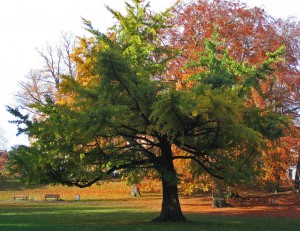
The healing properties of ginkgo were recognized long before being studied by scientists. The beginning of the study dates back to the 60s of the twentieth century. Doctors literally collected information about possible medicinal properties tree leaves. They were especially interested in the recipes of the herbalists of the East, those places where the tree originally grew. Specialists investigated the physiological effects of dry and fresh plant compounds on the human body, studied physicians and chemical composition elements.
They informed the public about the results through publication in medical journals, discussed at research councils.
Biological and chemical experiments have revealed that most of the valuable substances and compounds are found in the leaves of the tree. The biological substances that make up the structure of the leaves consist of natural stimulants that saturate a person with the power and strength of centuries-old trees. The results of scientific studies confirmed the unique special effect of the tincture created on the basis of the leaves in the treatment of chronic diseases vessels.
A scientific study of biloba researchers took place in almost all countries where they began to take the remedy: America, Europe, Japan. Leaves and branches medicinal tree ground into powder, converted into a thick mixture. The application went as a means of slowing down the aging process of the brain.
Medical discovery of tincture properties
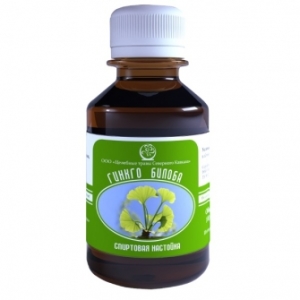
The effectiveness of biloba leaves is recognized as a real scientific sensation. In Germany, France, scientists recorded the effect of recovery of a large number of patients. In the United States, various medicinal mixtures based on ginkgo leaves began to be manufactured and produced. Today, the formulations are among the leading group of natural herbal medicines sold in the country. The extract is prescribed by French experts. The popularity and demand for tinctures in Germany has been recognized and described by various publications. According to Purdue University Doctor W. Tyler, the leaves of the unique tree of the East are one of the most valuable medicinal plants sold in Europe.
Prescriptions of doctors are aimed at stopping the aging of human mental activity. They recommend taking it to restore declining memory functions, improve performance, enhance brain function. Due to the excellent results of the extract, the recipes of Chinese doctors have become widely popular in European countries.
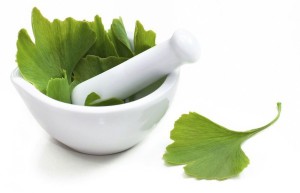
The properties of alcohol tincture strengthen the elasticity and strength of the circulatory system. Capillary walls are fixed. Ginkgo has the ability to expand and cleanse blood vessels, improve blood circulation. This quality is especially valuable in functional brain disorders. Blood increases flow through the arteries, lowers cholesterol levels. The medicinal drink produces an antihypoxic effect, increases oxygen absorption, and saturates the brain with glucose. The use of Biloba interferes with the process of lipid oxidation, prevents the formation and appearance of tissue edema in the brain, in peripheral tissues. All the main properties of the remedy reduce the level of blood pressure.
The tincture is unique in its ability to establish protection, restore impaired blood circulation, formed due to vascular spasm. The healing mixture restores blood flow. Increased or restored blood flow eliminates the possibility of complications and side effects away from traditional medicines(hypotensive).
The blood flow enhances the work of almost all the vessels of the body, the work of the brain is normalized. The importance for a person lies in the fact that any cell cannot work in full accordance with the norm if its blood supply is reduced or worsened.
Treatment effectiveness
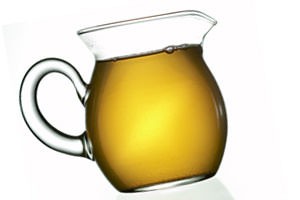
Tincture of leaves for alcohol is considered effective and effective in the treatment of complex human diseases.
- Disorders of the cardiovascular system;
- Lack of activity of the cerebrovascular system;
- Multiple stage sclerosis;
- Alzheimer's disease, accompanied by a decrease in the mental functioning of the brain;
- Decreased memory, mental abilities, regardless of age;
- Deterioration of the blood supply to the limbs (arms, legs);
- Varicose veins and thrombophlebitis;
- Chronic stages of bronchitis, asthma;
- Consequences associated with the post-stroke condition of the patient;
- Otolaryngological complications;
- Frequent manifestations of pain in the head, dizziness, migraine;
- Haemorrhoids;
- Decreased vitality and functioning of the genital organs;
- Diabetes.
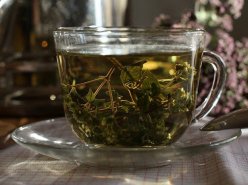
The tincture is advised to prepare in accordance with the technology described in Chinese literature, preserved in the annals. The exact repetition of the recipe of the past century gives a high result of the effectiveness of the remedy. Usage scheme:
10-15 drops are diluted in water (volume - half a glass). It is taken in two sessions a day, preferably before meals. The course of admission is 30 days. During the year, it is advised to repeat the course of treatment about three times.
Ginkgo biloba (Ginkgo biloba).
Other names: ginkgo biloba, temple tree, silver fruit, silver apricot, girl's braids.
Description. Monoecious, gymnospermous, deciduous, relict tree of the Ginkgo family (Ginkgophyta). It has a well-developed, branched, deeply penetrating root system. Young trees have a central root over 100 cm long.
The trunk of the tree is slender, branching, with a spreading crown, with brown-gray bark. In old trees, the bark is furrowed, cracked. Tree height up to 30 m, trunk diameter up to 1.5-2 m or more.
The leaves are bilobed, on long petioles, fan-shaped, with fan-shaped venation, naked, leathery, slightly corrugated along the edge, up to 10 cm long and up to 12 cm wide, bright green (yellow in autumn).
Male and female flowers are located on different trees. Male flowers in the form of catkins with numerous stamens. Female flowers in the form of two green ovules on a long pedicel. Pollination occurs with the help of wind.
Ginkgo biloba blooms in May - June. Fruit ripening in October. The fruits are round, fleshy, first green, later yellow with a bluish bloom. Seeds with an unpleasant odor, burning-astringent taste.
Ginkgo Biloba is native to Northeast China. The tree is currently distributed in East Asia, China, Japan. Ginkgo biloba grows in cool valleys at an altitude of up to 770 m above sea level. It forms small groves along with coniferous and other deciduous trees. As an ornamental plant, this tree is cultivated in Russia, Ukraine, Moldova, on the Black Sea coast of the Caucasus, in North America.
Ginkgo biloba prefers loamy soils with deep groundwater. The plant is photophilous, frost-resistant, grows slowly, propagates by seeds and vegetatively. Life expectancy of 1000 years or more.
Collection and preparation of raw materials. For medicinal purposes, the leaves and seeds of ginkgo biloba are used and harvested. Leaves can be harvested throughout the growing season. Seeds are harvested after the first frost, after which the fruits begin to fall off. The fruits are harvested, the seeds are separated from the pulp, washed with water. Dry on wire racks in ventilated rooms at room temperature.
The leaves are dried in the shade outdoors in the shade or in a room with normal ventilation. Dried raw materials (leaves and seeds) are stored in closed glass jars, in a dry place, protected from light. Shelf life 2 years.
Plant composition. Ginkgo biloba leaves contain quercetin, kaempferol, bilobetin, ginkgetin, hexacosanol, nonacosan, pinit, acids (linolenic, shikimic, quinic, hydroginkgolic), starch, pentosan, wax, fatty and essential oils. Seeds contain proteins (up to 13%), starch, fatty oil, pentosan, sugars, arginine, sitosterol, phytosterol, carotene, asparagine, xylan, ginkgetin, gynol.
Ginkgo biloba application, properties.
Preparations from the leaves of ginkgo biloba have antispasmodic, vasodilating, bacteriostatic, antioxidant, decongestant, antihelminthic properties.
These drugs improve blood circulation in the brain, and contribute to the delivery of oxygen to the tissues. However, they do not affect the heart rate and respiratory acts. In scientific medicine, these drugs are prescribed as an activator of blood vessels in arteriosclerotic angiopathy, diabetic vascular lesions with the threat of gangrene, with vascular damage by nicotine in smokers, with Raynaud's disease (vasospasm of the extremities), with bronchial asthma.
Ginkgo biloba has a positive effect on the aging body (behavioral and psycho-emotional disorders associated with cerebral vascular insufficiency). Regular intake of ginkgo biloba preparations improves memory, concentration, eliminates or reduces dizziness, headaches.
Ginkgo biloba leaf tincture is used for diseases of the cardiovascular system, cerebrovascular insufficiency, multiple sclerosis, intermittent claudication syndrome, migraines, headaches, retinopathy, tinnitus, bronchial asthma, impotence, premenstrual syndrome, toxic shock for the prevention of stroke and heart attack. Ginkgo biloba extract is also used for these purposes.
A decoction of the leaves of ginkgo biloba is drunk with sclerosis of cerebral vessels in the elderly, venous insufficiency and varicose veins veins, with hemorrhoids.
Ginkgo biloba seeds are used in Chinese medicine. They are used for lung diseases (cough, asthma, tuberculosis), constipation, and as a sedative. Toasted seeds in in large numbers can be eaten (in large quantities cause poisoning). Raw seeds have an antidote and carcinostatic effect.
Dosage forms and doses.
Tincture of Ginkgo biloba leaves. Prepared on 40% alcohol in a ratio of 1:10. Infuse for 14 days in a dark place, shaking occasionally, then filter. Inside take 15 drops per 70 ml of water 2 times a day. Take 1 month. Within 1 year, 3 courses are recommended.
decoction of ginkgo biloba leaves. 2 tablespoons of dry crushed leaves in a glass of water, boil for 3 minutes after boiling, remove from heat, leave for 10 minutes, filter. Take a third of a glass 3 r. per day for 1 month. Within 1 year, 3 courses are recommended.
The industry also produces ginkgo biloba extract and preparations based on it. Take them in accordance with the manufacturer's instructions.
Contraindications. Ginkgo biloba preparations are contraindicated in children under 12 years of age, also during pregnancy and lactation.
Ginkgo biloba is a unique, relic plant. Taoist monks consider it a symbol of yin and yang energy, the keeper of wisdom. Ginkgo is a dioecious plant (there are female and male trees). Today ginkgo biloba is grown as a helper for preservation of youth and intelligence. And you can grow it yourself, at home, from seeds. Ginkgo seeds are protected by a peel consisting of three layers, they are very fragrant (although it is difficult to notice this from dry seeds from a bag), they resemble nuts (about the size of a hazelnut, but different appearance). They are easy to buy, it is no longer a shortage. You can also buy a ready-made young plant. You can also propagate by layering, cuttings from an adult tree.
Its name means "silver apricot". Its seeds are really silvery in color.
- one leaf on a separate petiole, such leaves grow quickly
- shorter petioles, on which 4 separate leaves sit, grow slowly
The male tree is covered with catkins in which pollen ripens. Female plants bear special rudiments in which seeds are tied after pollination. Pollination occurs with the help of wind.
It is possible to distinguish what type a tree belongs to, male or female, only after sleeping for many years, only in the 25th - 30th year of the tree's life, when special signs appear. These trees are real centenarians, specimens are known to be 2.5 thousand years old.
Growing ginkgo outdoors
In nature, the ginkgo tree requires a very large area, the location should be light, because ginkgo is a light-loving culture. The tree does not tolerate transplanting very well, so you need to plant it immediately in a permanent place (and avoid places with a close location of groundwater). It is necessary to plant in prepared pits with fertile soil, with the addition of ash and mineral fertilizers.
In the first years of life (at least three years), a young tree practically does not give growth, but actively grows the root system. During these years, watering is required, the roots should not dry out. In winter, in the first years, it is desirable to cover the seedling with snow, spruce branches.
Gingo winters in the Moscow region in open field(young plants - under cover). With age, the winter hardiness of plants increases.
Ginkgo as a whole is an unpretentious tree, it will adapt to different growing conditions, practically does not get sick.
In autumn, the leaves turn an attractive golden-yellow color, and then fall off.
The ginkgo tree can be planted on the streets in cities because it tolerates dust, gas and smoke well, and is resistant to infections and pests. Ginkgo is very powerful root system, it is resistant to very strong winds. It tolerates short-term frosts down to minus 30°C.
Growing ginkgo at home as a houseplant
Ginkgo Bonsai.
Yes, it can be grown indoors! At home, a miniature species is grown - ginkgo bonsai, it is considered one of the most outstanding examples of bonsai.
- prefers a place without direct sunlight, diffused light is needed;
- loves high humidity, needs frequent spraying;
- in summer, it is optimally not higher than +22 degrees, and in winter + 8-12 degrees (about two months, a state of rest is necessary);
- for pruning, choose the period of active vegetation.
Ginkgo bonsai, dormant (without leaves).
It is possible to grow at home only if it is possible to provide a cold winter! If the winter temperature regime is not maintained, the cycle of the plant goes astray, it can confuse winter with summer, which leads to death.
In summer, it is highly desirable to take the pot with it into the fresh air (balcony, garden ...).
The plant is deciduous, but looks great at home and without leaves. At home, he later throws off the foliage and overgrows earlier than on the street. During the season, the tree grows by 7-15 cm, its stem noticeably thickens.
Planting ginkgo seeds
Only seeds of fresh collection have high germination. Germination directly depends on the freshness of the seeds. When buying seeds, there is no need to talk about freshness, here it’s how lucky. It happens that even a dozen bags (usually 2 seeds inside) do not give a single shoot. Sometimes, on the contrary, the seeds sprout together. You can order seeds from Sochi and other southern regions privately. If the seeds are stored for six months at room temperature, their germination capacity drops by half. Further - even faster.
The seeds are similar in appearance to an apricot pit, but lighter in color.
Seeds are planted to a depth of 5-7 cm. Film shelter, planting in a greenhouse will increase the percentage of seed germination.
Shoots of ginkgo begin to appear about a month after sowing, but may appear only after 3 months. Young ginkgo grow slowly, giving very little growth. Seedlings can be planted in a permanent place in a year.
Benefits of ginkgo biloba
Ginkgo biloba is used in the preparation of medicines, it is believed that they help to rejuvenate the body. It is a valuable medicinal plant, has a rejuvenating effect. Prepared from leaves medical preparations to improve cerebral circulation, with atherosclerosis, diabetes, sleep disorders.
Ginkgo has been used as a medicine since ancient times. Medicines based on ginkgo biloba leaf extract are popular in different countries peace. Contains flavone glycosides, which include kaempferol, quartzetin, gingolide, terpenes - ginkgolides, bilobalides. The therapeutic effect is based on the fact that ginkgo contains specific substances (ginkgolides and bilobalides), which there is no longer a single plant that currently exists on the planet. If you still doubt whether it is worth allocating this tree the best place on the site, this should convince you that it is definitely worth it! These substances increase the elasticity and strength of the walls of blood vessels, have vasodilating properties, and suppress inflammatory reactions.
Ginkgo biloba leaf extract:
Young ginkgo tree.
- reduces the level of cholesterol in the blood;
- improves blood circulation in case of functional disorder of cerebral vessels;
- reduces the tendency to form clots and blood clots in veins and arteries;
- normalizes pressure;
- enhances the speed of thought.
It also contains micro and macro elements (selenium, manganese, titanium, copper, phosphorus, calcium, potassium, magnesium, iron), organic and ginkgoic acids, amino acids, waxes, steroids, essential oils, alkaloids, vitamins.
This unique complex is only for ginkgo. No other plant can replace it in this case. Yes, you can search for dietary supplements containing gingko, but there are always doubts, is it not a fake, and is the manufacturer honest? The safest thing is to grow the tree yourself. Moreover, it is not only useful, but also such amazingly beautiful!
Taoist monks considered this plant a symbol of yin and yang energy, believing that the tree is the keeper of wisdom. Contemporaries prefer to grow ginkgo biloba as a universal remedy for preserving youth and intelligence. How to ensure proper care for a unique relic plant - this article will tell.
Ginkgo biloba: famous varieties and varieties
In the botanical world, they have long argued about the belonging of ginkgo to a particular family. The thing is that the plant is botanically closer to coniferous crops. For a very long time, ginkgo was attributed to gymnosperms, representatives of this group are pine and spruce trees. However, the striking differences between the tree and conifers allowed scientists to suggest that ginkgo biloba is a direct descendant of ancient ferns. It is believed that these plants were widespread in the Mesozoic era, and their habitat extended to the territory of modern Siberia.
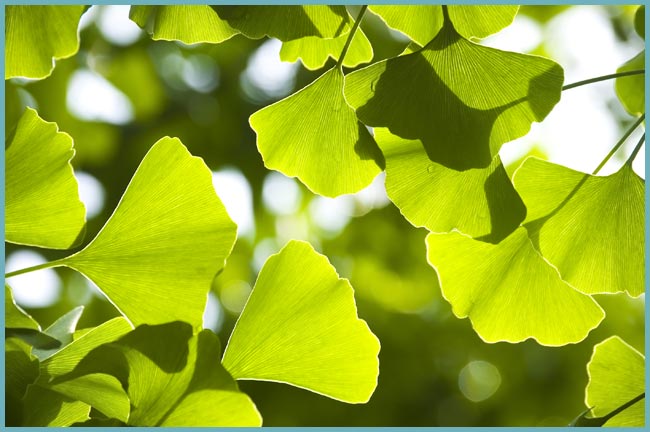
Healing tree - ginkgo biloba
Currently, wild thickets of trees are found in China. In the Russian territory, ginkgo plantings can be found in small numbers on the Black Sea coast.
Ginkgo biloba is a deciduous plant with a unique leaf blade shape: a tree leaf looks like a fan, the width of which reaches 8 cm. A rather large leaf is supported by a thin long petiole (up to 10 cm). With the onset of autumn cold, the leaves quickly fall from the trees.
There are two types of leaves: the first grow one at a time on a separate petiole, the second type is characterized by shorter petioles, on which 4 separate leaves sit. The first type of leaves grows and develops very quickly; the second type - considerable time is spent on the full development of the leaf. In the photo you can see two types of tree leaves.
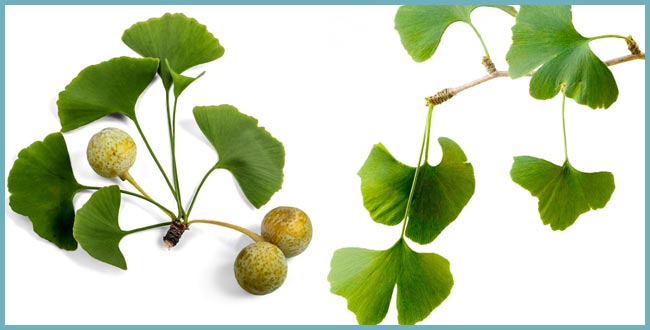
Two kinds of leaves
Unique plants are divided into male and female: ginkgo refers to dioecious plants.
- The male tree is covered with catkins, in which pollen ripens for pollination of females.
- Female plants bear special rudiments in which seeds are tied after pollination.
It is possible to distinguish which type a tree belongs to only at the age of 25 - 30 of its life, only then special signs appear.
Pollination in nature occurs in the spring months with the help of wind, which carries the ripened pollen over considerable distances. Fruit ripening lasts until late autumn. Ginkgo seeds are protected by a three-layer rind and have an extremely unpleasant odor.
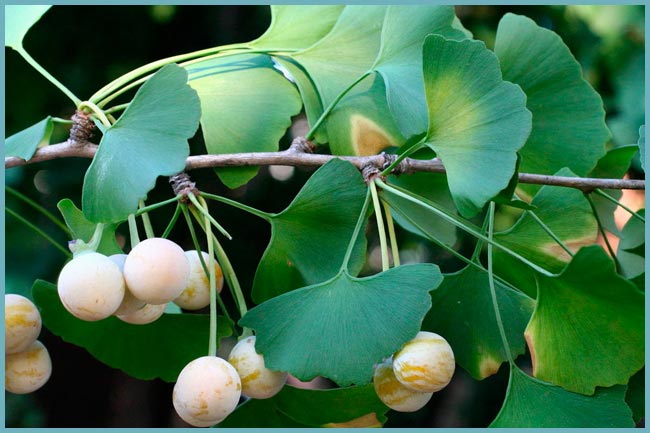
ginkgo biloba fruit
There are trees that have survived to the 2500th anniversary. Unique photos of gigantic trees that have survived centuries-old anniversaries make it possible to be convinced of the beauty and impressiveness of these plants.
Ginkgo biloba: the right fit
When choosing a place to plant a tree, you should immediately foresee that the plant will need a very large area, while the location should be the brightest - ginkgo is a light-loving culture. A place for growing must be chosen permanent - the tree does not tolerate transplanting very well.
In the first years of life, for about three years, culture practically does not grow. At this time, the development and strengthening of the root system takes place.
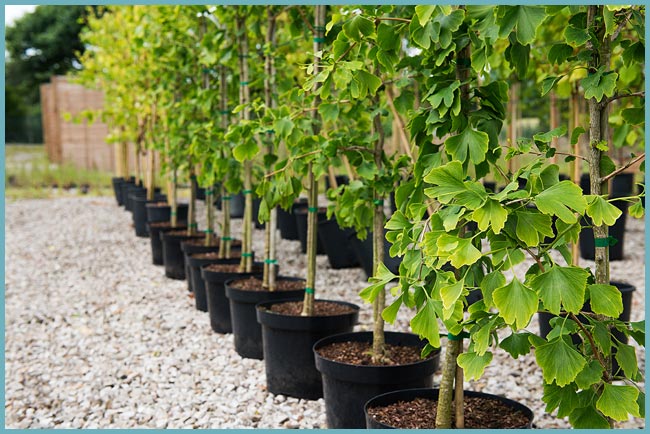
young plants
Seedlings are placed in special pits filled with fertile soil. When planting, you need to strictly monitor the location of the roots - they must be straightened and located freely in the pit. Requires uniform periodic watering - you can not dry the roots in the first years of life.
Advice! With a close occurrence of groundwater at the landing site, it is better to choose a drier place.
Seedling care - growing a healthy tree
Caring for a young tree comes down to periodic watering, loosening the soil and freeing the plant from weeds. Ginkgo is a very hardy tree that tolerates many growing conditions.
Advice! In winter, the tree should be covered with snow or spruce branches. The lower ends of the branches may freeze, but with the advent of spring, the branches will quickly cover the green leaves.
Nutrients can be applied to the planting hole: ash or mineral fertilizers. In summer, young seedlings can be fed with complex compounds, applying them in liquid form under the root or as foliar top dressing on the leaves.
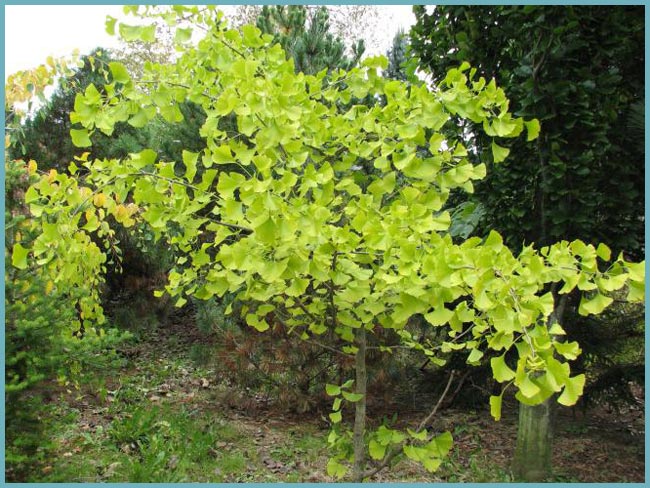
Pests and diseases do not harm the tree
Ginkgo biloba rarely gets sick, the plant is very resistant to any kind of disease. In winter, mice and hares can gnaw the bark of the stem.
Ginkgo reproduction
You can propagate a rarity tree with the help of seeds and layering.
layering you need to take from mature trees, it is best when it is already definitely known whether it is a male or female specimen. Chopped cuttings are rooted in greenhouses in light soil. This operation should begin in the first half of summer. When rooting cuttings cut from the mother plant with part of the wood, it is useful to use root stimulants. Leaves from the cutting are removed up to 50%.
Important! Rooted cuttings develop slowly and require daily spraying on the leaves, especially in hot weather.
Only have high germination seeds ginkgo is freshly harvested, therefore, during seed propagation, germination directly depends on the freshness of the seeds. The seeds of the plant resemble an apricot kernel, only they are white in color.
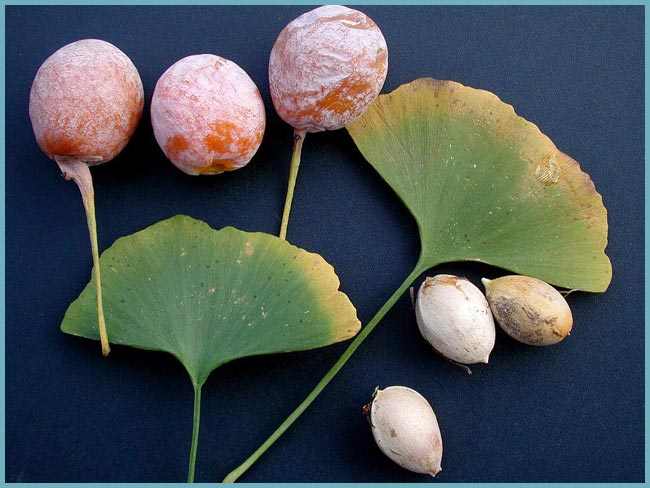
Ginkgo biloba seeds
Sowing seeds can be done in early spring. They are closed in boxes to a depth of 7 cm. Film shelter will increase the percentage of seed germination and shorten the time for obtaining young plants. Ginkgo shoots begin to appear about a month after sowing. Trees grow slowly, giving very little growth. Seedlings can be planted in a permanent place in a year.
Ginkgo biloba has a huge list of useful properties, it is used to prepare all kinds of medicines that have a beneficial effect on the rejuvenation of the body. It is worth growing this rarity because of the unusual nature of this culture.
Growing a rare culture of Ginkgo Biloba: video
Ginkgo Biloba: photo
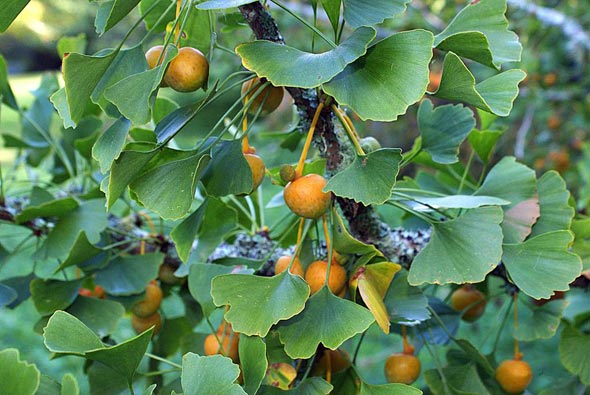
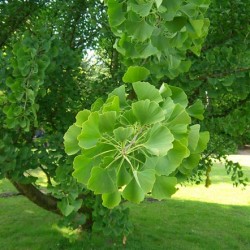
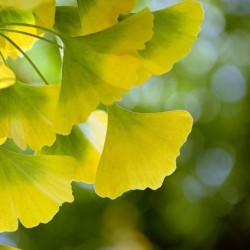
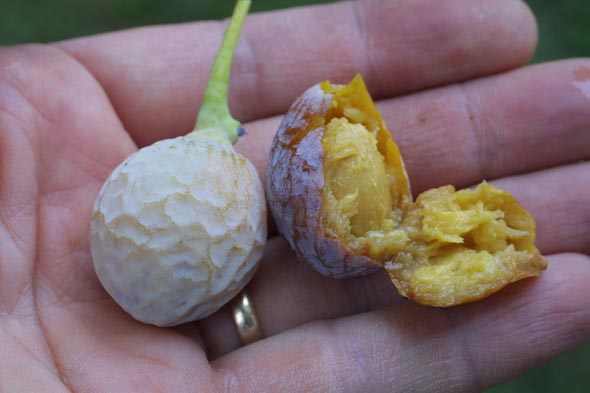
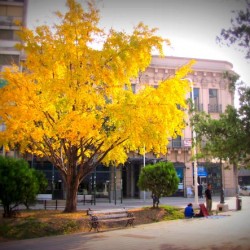
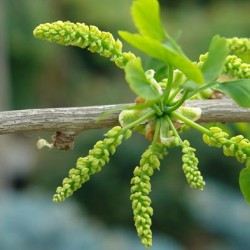
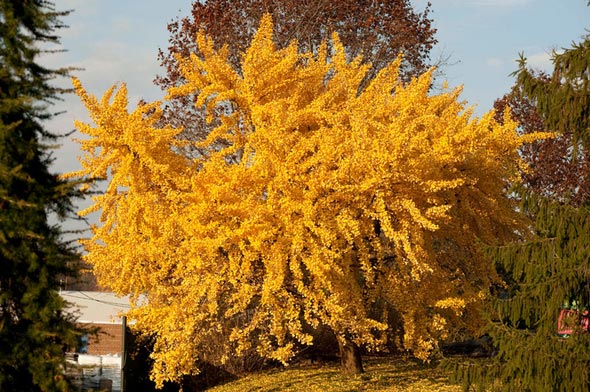
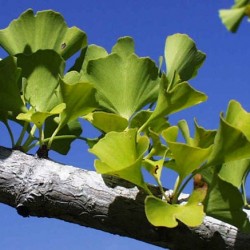
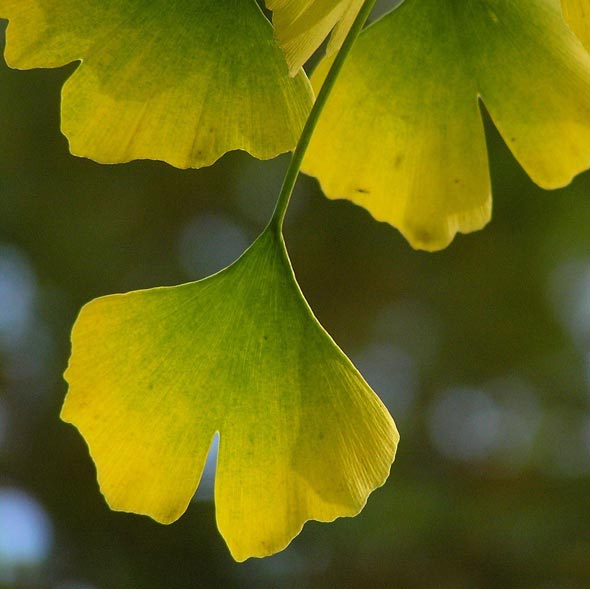
A very small number of plants have survived on Earth from ancient times to this day. That is why the discovery of scientists in Western China is surprising. The woody medicinal plant Ginkgo Biloba, found by them, is named so by the Japanese, the literal translation sounds like “silver fruit”, or “silver apricot”. The fruits of this plant are called ginkgo, they were described in his writings by Charles Darwin, calling them “living fossils”.
There are many interesting moments in the history of Ginkgo Biloba. For example, this plant, which appeared in the 11th century, was already considered medicinal then. In Japan and China, it was even planted near sacred temples. In England, this plant was nicknamed the "girl's hair tree", as they saw the similarity in the forms of Ginkgo leaves and fern leaves, known as "Venus hair".
The oldest specimen of Ginkgo, the so-called "veteran tree", grows in a forest cemetery in Philadelphia and is under the protection and supervision of specialists. Ginkgo arrived in America in 1784.
medicinal properties plants
Some of the healing properties of Ginkgo Biloba explain its use in medicine. It's no secret that with age, the blood supply to the human brain deteriorates significantly. The composition of the plant includes ginkgolide - a substance that helps to increase the flexibility of the walls of blood vessels in the brain. Other useful property ginkgolide - promoting vasodilation. All this contributes to the supply of the brain nutrients, and the brain receives oxygen in sufficient quantities, and the process of liberation from toxins is also underway.
Another important property of Ginkgo is the ability to lower blood cholesterol levels, and as a result, to reduce the likelihood of heart attacks.
Proanthocyanidins and flavoglycosides, which are part of Ginkgo Biloba, protect the walls of blood vessels from free radicals. These same substances improve blood circulation and activate the mental activity of the brain.
Indications for use
Medicines from Ginkgo Biloba are recommended for use as prophylactic tonics, as well as for the prevention of atherosclerosis, prevention of cerebral circulation disorders and vision and hearing functions. They are used as a means to eliminate migraines, improve memory, and also as a prophylaxis for neurodystrophic diseases (Parkinson's and Alzheimer's diseases), a number of disorders of dystonic cerebral venous systems and dyscirculatory encephalopathies. It should be used for disorders of sexual function. It is impossible to ignore the fact that this medicinal plant improves blood circulation in the limbs in patients with Raynaud's syndrome and helps with scleroderma (a rare autoimmune disease), chronic fatigue syndrome, bronchial asthma, and diabetes mellitus.
The use of the plant helps to increase the strength and elasticity of the walls of capillaries, the walls of blood vessels, enhances cerebral blood flow in the capillary, venous and arterial bed, lowers blood cholesterol levels. It has a decongestant effect on brain tissue, increasing the consumption of glucose and oxygen by the brain.
The Ginkgo plant has a stimulating effect on the biosynthesis of prostanoids (substances that increase blood vessels), due to its ability to inactivate free radicals. And this means that the plant is able to prevent high blood pressure.
By using Ginkgo extract, stagnation of blood in the peripheral vessels can be avoided, as it increases blood flow to the brain.
In case of insufficient blood supply, the cells of the body cannot function normally. Ginkgo increases blood flow to areas where it is needed. It promotes blood flow to the brain, arms and legs, thereby regulating the tone and elasticity of arteries and tiny capillaries. Reduces blood viscosity, reduces the risk of blood clots.
So, the use of the medicinal plant Ginkgo Biloba is recommended for the following diseases:
Cardiovascular diseases,
cerebrovascular insufficiency,
Age-related mental disorders
Alzheimer's disease (slows the progression of the disease, improves memory and concentration),
Poor blood supply to the extremities (feeling cold in the extremities, painful leg cramps),
Phlebeurysm,
Diabetes,
Vascular diseases of the ear, with hearing loss,
Impotence,
thrombophlebitis,
Haemorrhoids,
Migraine.
Ginkgo tincture is easy to prepare , so without much difficulty you can cook it yourself. Ginkgo leaves must be dried first. Pour 40% alcohol solution (ratio 1:10). Insist in a dark cool place for 2 weeks. Strain the tincture after. Take 2 times a day (10-15 drops of tincture in half a glass of water), before meals for 1 month. It is recommended to take the course 3 times a year.
Contraindications
Do not exceed the dose - this can cause disorientation and other CNS disorders. Ginkgo is contraindicated for pregnant women. Do not apply medications on the basis of this plant, if there is a predisposition to allergic reaction on its components. Do not take Ginkgo in case of bleeding disorders, as well as in the event of an upcoming surgical intervention.







